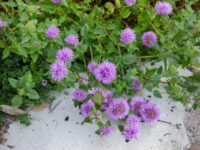
Tom Karwin, On Gardening | Planting during the fall season – Santa Cruz Sentinel
Because the autumn equinox (Sept. 22) is approaching, now is the time to plan for seasonal tasks.
This column traces the development of my butterfly garden, which we started early this year. To review the related columns, browse to santacruzsentinel.com and search for “karwin and butterfly.”
Our photo gallery includes some of the perennial plants we are considering for this garden bed. We downloaded the images from Wikimedia Commons (commons.wikimedia.org/), with captions edited from plant descriptions from the California Native Plant Society’s Calscape website (calscape.org). Both are extraordinary resources for gardeners.
Background of the project
This project began with removing a large shrub, a Red Clusterberry (Cotoneaster lacteus), a native to China’s Yunnan province. We enjoyed the presence of this plant in the garden, but it’s an invasive species, spreading primarily by birds eating the berries and distributing the seeds widely.
After the removal, the bed had only one plant, a well-established Lewis’ Mock Orange (Philadelphus lewisii), a California native. This is an attractive deciduous shrub in the Hydrangea plant family (Hydrangeaceae). It produces large flowers with four white petals and numerous yellow stamens. In spring and summer, the plant is covered in a mass of blossoms that form an attractive garden focal point. The flowers are among the most fragrant of any California native plant, with a heavy, sweet scent similar to orange blossoms with a hint of pineapple.
We developed the bed, measuring 9 feet by 30 feet, to support butterflies that grow and live in this area by selecting flowering plants native to this part of California. This approach would serve both categories of Lepidoptera: butterflies during the day and moths at night.
While we generally favor perennial plants, the project was already well into the winter months, and we needed more time to select and install plants. Using Calscape, we chose nine varieties of locally native annual plants that would blossom by the spring. They would serve the Lepidoptera quickly and then self-seed for the next season. This approach provides time to select, acquire and install butterfly-friendly perennials.
To develop the bed, we planted 17 different annuals, some as seedlings but mostly as seeds. These varieties are listed in a previous column in the Sentinel’s archive, cited above.
Although these annuals soon produced flowers, we saw only limited visits from butterflies. Perhaps we needed to look during their feeding times!
The next development
Selecting perennials for this bed continues to support the local Lepidoptera by installing locally native plants.
As noted, a fragrant Mock Orange shrub is an attractive feature at one end of the bed. It is native to northern and eastern areas of California, not the state’s central coast, and not particularly supportive of butterflies. Still, we will keep that plant.
The additional perennial plants should be smaller than this tall shrub, providing a complementary landscape.
The Calscape website is our readily available and reliable source of plant options for this project. Using the site’s search function, we generated a list of plants that meet our goals by using several filters: Perennials, Shrubs, Attract Butterflies, and Size of 1-3 feet in height.
These filters produced a list of 64 plants that meet these criteria. Several listed plants are recognizable, but some are unfamiliar and not personally appealing. The selection process involves clicking on each plant to review the Calscape’s thorough information. This requires time to rate each option as Good, Bad or Consider.
The most unfamiliar plants are relatively rare, with little or no availability from nurseries. These options are easily rated as Bad only because they would be challenging to acquire for this project.
The plants in this column’s photo gallery represent the Good options based on our initial quick review of Calscape’s list. These are not final decisions! We still have time to consider this list’s other options and modify the search filters to generate different lists. For example, we might change the filters to screen plants with 2-4 feet in height, full sun exposure, and moderate water requirements.
The Calscape approach to selecting California native plants is manageable in detail and ultimately more satisfying than the too-common practice of roaming through a garden center and choosing plants that attract the eye.
Another online resource for this project is provided by the Xerces Society for Invertebrate Conservation (xerces.org), which focuses on butterflies and other pollinators. The Xerces Society’s list of “Recommended Plants for Pollinators & Beneficial Insects for the California Central Coast Region” can be accessed by browsing tinyurl.com/289p4tmj.
The design of this bed will likely involve clusters of three or even five plants of each variety to create a coherent landscape rather than a hodge-podge plant collection.
In a future column, we’ll list the final selection of plants for this butterfly garden.
Enjoy your garden.
Tom Karwin is a past president of Friends of the UC Santa Cruz Arboretum and the Monterey Bay Iris Society, a past president and Lifetime Member of the Monterey Bay Area Cactus & Succulent Society, and a Lifetime UC Master Gardener (Certified 1999-2009). He is now a board member of the Santa Cruz Hostel Society, and active with the Pacific Horticultural Society. To view photos from his garden, https://www.facebook.com/ongardeningcom-566511763375123/ . For garden coaching info and an archive of On Gardening columns, visit ongardening.com for earlier columns or visit www.santacruzsentinel.com/ and search for “Karwin” for more recent columns. Email comments or questions to gardening@karwin.com.









